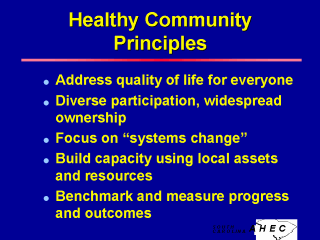 |
Address
quality of life for everyone Healthy communities strive to attend to the basic
emotional, physical and spiritual needs of everyone in the community. Diverse citizen
participation and widespread community ownership In healthy communities, all people
take active and ongoing responsibility for themselves, their families, their property and
their community. A leader’s work is to find common ground among participants so that
everyone is empowered to take direct action for health and influence community directions.
Focus on “systems change” This is about changing the way people live and
work together. It is about how community services are delivered, how information is
shared, how local government operates, and how business is conducted. It’s about
resource allocation and decision making, not just “nice” projects.
Build capacity using local assets and resources This means starting from
existing community strengths and successes and then investing in the enhancement of a
community’s “civic infrastructure.” By developing an infrastructure that encourages
health, fewer resources will need to be spent on “back end” services that attempt to
fix the problems resulting from a weak infrastructure.
Benchmark and measure progress and outcomes Healthy communities use performance
measures and community indicators to help expand the flow of information and
accountability to all citizens, as well as to reveal whether residents are heading toward
or away from stated goals. Timely, accurate information is vital to sustaining long-term
community improvement.
From: Healthy People in Healthy Communities, Coalition for Healthier Cities and
Communities |
